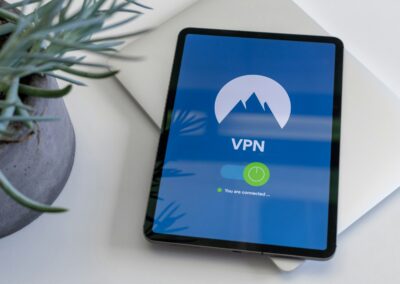Enhancing Data Protection in Cloud and Multi-Cloud Environments with Zero Trust
The Evolution of Zero Trust Security
Zero trust security models, which operate on the principle of “never trust, always verify,” have emerged as a vital solution for protecting sensitive data in these dynamic environments.
Zero trust security models shift the traditional security paradigm by eliminating implicit trust within the network. Every access request is thoroughly verified, regardless of whether it originates from inside or outside the network. This approach is particularly relevant for cloud environments, where the perimeter is no longer defined by physical boundaries but by a complex web of interconnected services and users.
In the context of business success, particularly in high-growth regions like Saudi Arabia and the UAE, adopting zero trust security models can provide a competitive edge. By ensuring that sensitive data is consistently protected, organizations can build trust with customers and partners, fostering stronger business relationships and driving growth.
Implementing Zero Trust in Cloud Environments
The implementation of zero trust security models in cloud and multi-cloud environments involves several key components. One of the foundational elements is identity and access management (IAM). By enforcing strict authentication and authorization processes, IAM ensures that only verified users and devices can access sensitive resources. This is crucial for preventing unauthorized access and reducing the risk of data breaches.
Another critical aspect of zero trust is network segmentation. By dividing the network into smaller, isolated segments, organizations can limit the lateral movement of threats. This means that even if a cyber attacker gains access to one part of the network, they cannot easily move to other segments. In cloud environments, where resources are often highly interconnected, network segmentation is essential for containing potential threats and minimizing their impact.
Moreover, zero trust security models leverage continuous monitoring and analytics to detect and respond to suspicious activities in real time. Advanced technologies such as artificial intelligence (AI) and machine learning (ML) play a significant role in this process. By analyzing vast amounts of data and identifying patterns, AI and ML can quickly detect anomalies and potential threats, enabling rapid response and mitigation.
Business Benefits of Zero Trust Security
Adopting zero trust security models offers numerous benefits for businesses, particularly those operating in technology-driven regions like Riyadh and Dubai. One of the most significant advantages is enhanced data protection. By verifying every access request and continuously monitoring network activities, zero trust models provide a robust defense against cyber threats. This is crucial for safeguarding sensitive data and maintaining compliance with regulatory requirements.
In addition to data protection, zero trust security models can improve operational efficiency. By automating security processes and reducing the reliance on manual interventions, organizations can streamline their operations and reduce the risk of human error. This leads to cost savings and allows IT teams to focus on more strategic initiatives, driving innovation and business growth.
Furthermore, the adoption of zero trust security models can enhance customer and partner trust. In today’s digital landscape, data breaches can severely damage an organization’s reputation and erode customer confidence. By implementing zero trust, businesses can demonstrate their commitment to data security, building stronger relationships with customers and partners and fostering long-term loyalty.
The Challenges of Zero Trust Implementation
While the benefits of zero trust security models are substantial, their implementation is not without challenges. One of the primary obstacles is the complexity of integrating zero trust principles into existing IT infrastructures. Organizations often have to overhaul their security architectures, which can be time-consuming and costly. This challenge is particularly pronounced in multi-cloud environments, where different platforms and services need to be seamlessly integrated.
Another challenge is the need for continuous monitoring and analysis. Zero trust security models rely on real-time data to detect and respond to threats. This requires advanced analytics capabilities and significant computational resources. Ensuring that the monitoring systems are up to date and capable of processing large volumes of data is critical for the success of zero trust initiatives.
Moreover, the human factor remains a significant challenge. Implementing zero trust requires a cultural shift within the organization. Employees need to be trained on new security protocols and best practices, and there must be a commitment to ongoing education and awareness. Without buy-in from all stakeholders, the effectiveness of zero trust security models can be compromised.
Best Practices for Successful Zero Trust Implementation
To overcome these challenges and successfully implement zero trust security models, organizations can follow several best practices. First and foremost, it is essential to conduct a thorough assessment of the existing IT infrastructure and identify areas that need improvement. This includes evaluating current security measures, understanding data flows, and identifying potential vulnerabilities.
Next, organizations should prioritize identity and access management. Implementing robust authentication and authorization processes is crucial for verifying every access request. Multi-factor authentication (MFA) and role-based access control (RBAC) are effective strategies for enhancing IAM.
Continuous monitoring and analytics are also vital components of zero trust security. Organizations should invest in advanced analytics tools that leverage AI and ML to detect and respond to threats in real time. Regular audits and assessments can help ensure that the monitoring systems remain effective and up to date.
Additionally, fostering a culture of security awareness is essential. Employees should be regularly trained on security best practices and the importance of zero trust principles. This includes understanding the risks of phishing attacks, recognizing suspicious activities, and knowing how to respond to potential threats.
Conclusion: The Future of Zero Trust in Cybersecurity
As organizations continue to embrace digital transformation and migrate to cloud environments, the need for robust security measures becomes increasingly important. Zero trust security models offer a comprehensive solution for protecting sensitive data in cloud and multi-cloud environments. By eliminating implicit trust and continuously verifying every access request, zero trust models provide a dynamic defense against evolving cyber threats.
In regions like Saudi Arabia, UAE, Riyadh, and Dubai, where technological innovation is a priority, the adoption of zero trust security models can drive business success and build customer trust. However, the implementation of zero trust is not without challenges. Organizations must be prepared to invest in advanced technologies, continuous monitoring, and employee training to ensure the effectiveness of zero trust initiatives.
By following best practices and committing to a culture of security awareness, businesses can successfully implement zero trust security models and protect their digital assets. As cyber threats continue to evolve, zero trust will remain a critical component of modern cybersecurity strategies, enabling organizations to thrive in the digital age.
#ZeroTrustSecurity #CloudSecurity #DataProtection #BusinessSuccess #LeadershipSkills #ProjectManagement #SaudiArabia #UAE #Riyadh #Dubai #ArtificialIntelligence #Blockchain #TheMetaverse #ExecutiveCoaching #GenerativeAI #ModernTechnology























